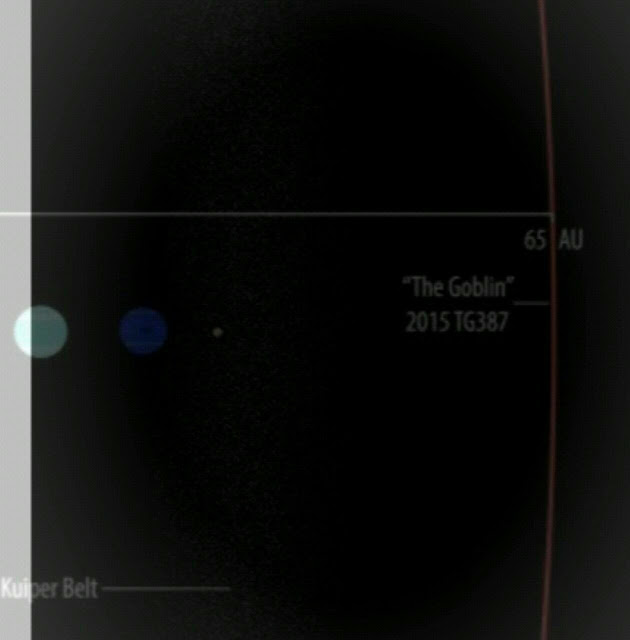"Finding a new dwarf planet in our solar system"
The supposed giant body, called planet X, outside our solar system is still puzzling scientists.
But the search for it resulted in the discovery of different, a dwarf planet, which is located about 2.5 times the distance between the distance between Pluto and the sun.
His name (2015 TG387) and the Goplin (Sprite), in addition, is very small even for a dwarf planet, barely 300 km in diameter.
But scientists are very excited, because the orbit of Guppelin is unusual and extraordinary, according to researchers, indicating that planet X is somewhere in the cold and dark.
It was found by astronomer Scott Sheppard of the Carnegie Endowment for Science, and his colleagues Chad Trujillo of the University of Northern Arizona and David Thuleen of the University of Hawaii.
When he discovered about 80 astronomical units (AU is the distance between the Sun and the Earth), the distance between Pluto and the Sun is 39.5 astronomical units, which is slightly different because its orbit is oval, reaching 29.7 astronomical units Perihelion) and 49.3 astronomical units (aphelion).
In fact, each planet and dwarf planet in our solar system has an oval orbit to some extent (none of which has an almost completely orbiting orbit of Pluto), but the orbit of Guppelin is very surprising, according to several years of observations to confirm the discovery and description of its orbit.
Its solar perpendicular point is about 65 astronomical units and is not the farthest solar perpendicular point. The solar perpendicular point of the bodies of the Orta cloud (VP113 and Sedna) is 80 astronomical units and 76 astronomical units, respectively.
But Goebblin goes much further - from 2012 (VP113) or Sedna, or any other body known in the solar system, except for some long-term comets.
Based on its course, its apogee is 2,300 astronomical units. By comparison, the Sedna point, previously considered the record, is 937 astronomical units.
Goplin takes 40,000 years to circulate around the sun only once; and because these objects are very far away, they are not affected gravitationally with planets such as Neptune or Jupiter.
"These objects, called TG387, 2012 (VP113) and Sedna (2012) are isolated from most of the known mass of the solar system, which makes them very interesting and can be used as a basis for understanding what is happening on the edge of our solar system. .
So, what does Goplin tell us?
According to Chipard and his colleagues, there is something there, a huge thing up to 10 times the mass of the Earth, something that pulls the orbits of these objects and makes them stretch with its enormous attractiveness.
"These faraway things are like the bread crumbs that lead us to planet X," says Sheppard. "The more we find out, the more we understand the outer solar system and the potential planet we think it gives its orbits, a discovery that will redefine our information about the evolution of the solar system."
The first planet was assumed to exist in 2014, when both Sheppard and Trujillo - after the discovery of VP113 2012 - first observed the long and interrelated orbits of similar objects - clustered together in a way that did not appear random. A giant planet too far from Pluto could attract it to form The observed pattern.
Not everyone agrees that planet X exists. Earlier this year, a research team proposed an alternative explanation for these exotic orbits, such as a barrage of rocks that shocked each other and then took strange paths in the same way as collision cars.
Other researchers also believe that there are obvious deviations in the detection of objects farthest away from Neptune, in other words; the data on which the assumption is based are defective.
Whether it exists or not, the search for the virtual planet has certainly led to other benefits, for example, the discovery of 12 new satellites for the buyer, announced earlier this year, and gave us information about the time when Jupiter was Still growing.
Of course, we now have Goblin, which can be directed by a giant planet according to computer simulations involving planet X and orbit, according to a paper published by Mike Brown and Konstantin Patigen of the California Institute of Technology in 2016.
"What makes this finding really interesting is that the 10th planet affects (TG387) in the same way as all other very distant solar system objects," says Trujillo.
"This simulation does not prove that there is another huge planet in our solar system, but it is further evidence that something big might exist."


تعليقات: 0
إرسال تعليق